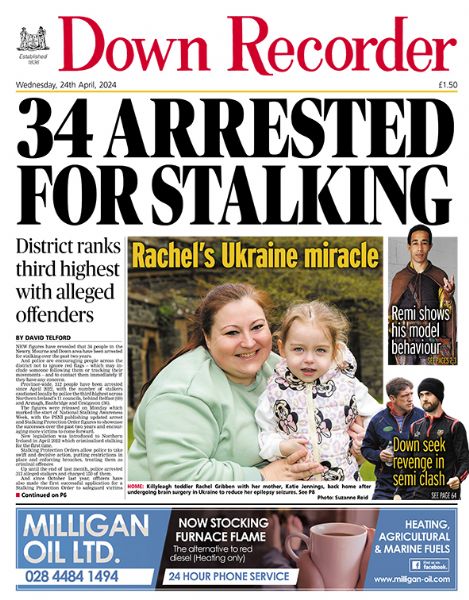Archaeological dig uncovers skeletons dating back to 8th century
Archaeological dig uncovers skeletons dating back to 8th century
17 April 2019
ARCHAEOLOGICAL material found at Downpatrick’s Cathedral Hill dates back as far as 725 years after the birth of Jesus.
Work from a Queen’s University Belfast team of archaeologists has dated skeletons buried some 300 years later, indicating a sizeable community living in Downpatrick at the time.
The material was recovered during last August’s four-week excavation and community investigation which attracted 2,500 visitors from around the world.
Local volunteers played a major role in uncovering the history of the site and there is another opportunity to get involved in another dig.
Newry, Mourne and Down Council chairman Mark Murnin is urging local people, particularly students, to get involved in another dig which is to take place this August.
“I visited the archaeological dig on Cathedral Hill several times in August last year and was impressed by the community involvement, the volume of tourist visits and of course the incredible finds being made from our rich early Christian and medieval past, just a stone’s throw from the traditional site of St Patrick’s grave,” he said.
“It’s exciting to hear about the new discoveries that are being made and the Early Christian dates of some of the finds, and I am delighted to announce that a second season of excavation is to be funded by the Special European Union Programmes Body for this August, as part of its PEACE IV Programme, when young people between 16 and 24 will be invited to take part in the dig for at least four days. It’s a great experience not to be missed.”
The material, including the discovery of 14 skeletons, has thrown up some interesting information on the Benedictine Abbey which occupied the site during the medieval period, as well as tantalising glimpses into the early Christian monastic site that was located there from the eighth century AD.
Three trenches were excavated in the immediate vicinity of Holy Trinity Cathedral, two located in the old tennis courts and one located on the grass verge directly in line with the Cathedral’s west door, in advance of the replica of St Patrick’s Cross being installed.
The trench on the verge revealed the existence of a substantial medieval cemetery with 14 skeletons being uncovered.
Three of these were put forward for radiocarbon dating and the dates have recently been returned.
The lowermost burial returned a date of 1031-1155 AD which indicates that this person lived and died before the Anglo-Norman invasion of 1177 AD and before the present Abbey church was constructed on the site.
This person would have lived at a time when the round tower — knocked down when the cathedral was refurbished around 1790 — was still in use. The latest burial encountered returned a date of 1317-1429 AD showing that this person lived and died when the site was occupied by the Benedictine Abbey.
Analysis of the skeletons is ongoing, but initial results of the latest burial indicate it to be a young, female, adult with severe dental trauma.
The excavation in the tennis courts uncovered the kitchen and midden pit of the Benedictine Abbey.
Site director Brian Sloan explained: “A rich picture of medieval life was uncovered with masses of animal bone and pottery being recovered. We can use this evidence to build up a picture of the diet and everyday activities of the monks who lived and prayed here. The large pottery sherds have been painstakingly pieced together at QUB giving an idea of the shape, size and decoration of the vessels.”
He continued: “A rich environmental picture is being established through the processing of the soil samples taken during the excavation. A multitude of blackberry seeds, sloe pips and fish bones have been recovered as well as charred wheat grains.”
Scientific techniques are now helping to identify and date the finds. An array of metalwork was recovered from the midden pit consisting of copper alloy and corroded iron artefacts, and these have been analysed and x-rayed. This has allowed us to see objects beneath the corrosion and the results have been quite startling. A number of items have been identified, including fine copper alloy dress pins, a socketed arrowhead, a horseshoe, a pair of iron shears and even a length of chain with a suspension hook still attached.
In addition, three samples — charred grain, charcoal and a fragment of twig — were put forward for radiocarbon dating.
The twig fragment returned a date range of 1228-1394 AD which fits very well with the pottery types recovered from the midden pit. However, the charred grain and charcoal returned very similar dates of 725-971 AD and 778-982 AD respectively.
This indicates that earlier activity relating to the early Christian monastic site of the 8th Century AD, when the original St Patrick’s Cross was erected, is there and waiting to be uncovered.
A number of finds have now been placed on display in the High Cross Gallery at Down County Museum, in two new cases funded by the British Museum Trust, while research work continues on the collection of artefacts, dating from the Mesolithic (c 7000 BC) through to modern times.
This project was supported by the European Union’s PEACE IV Programme, managed by the Special EU Programmes Body (SEUPB).
Match-funding for this project has been provided by The Executive Office in Northern Ireland and the Department for Rural and Community Development in Ireland.
To find out how to get involved in the excavation in August, contact Down County Museum on 028 4461 5218.

